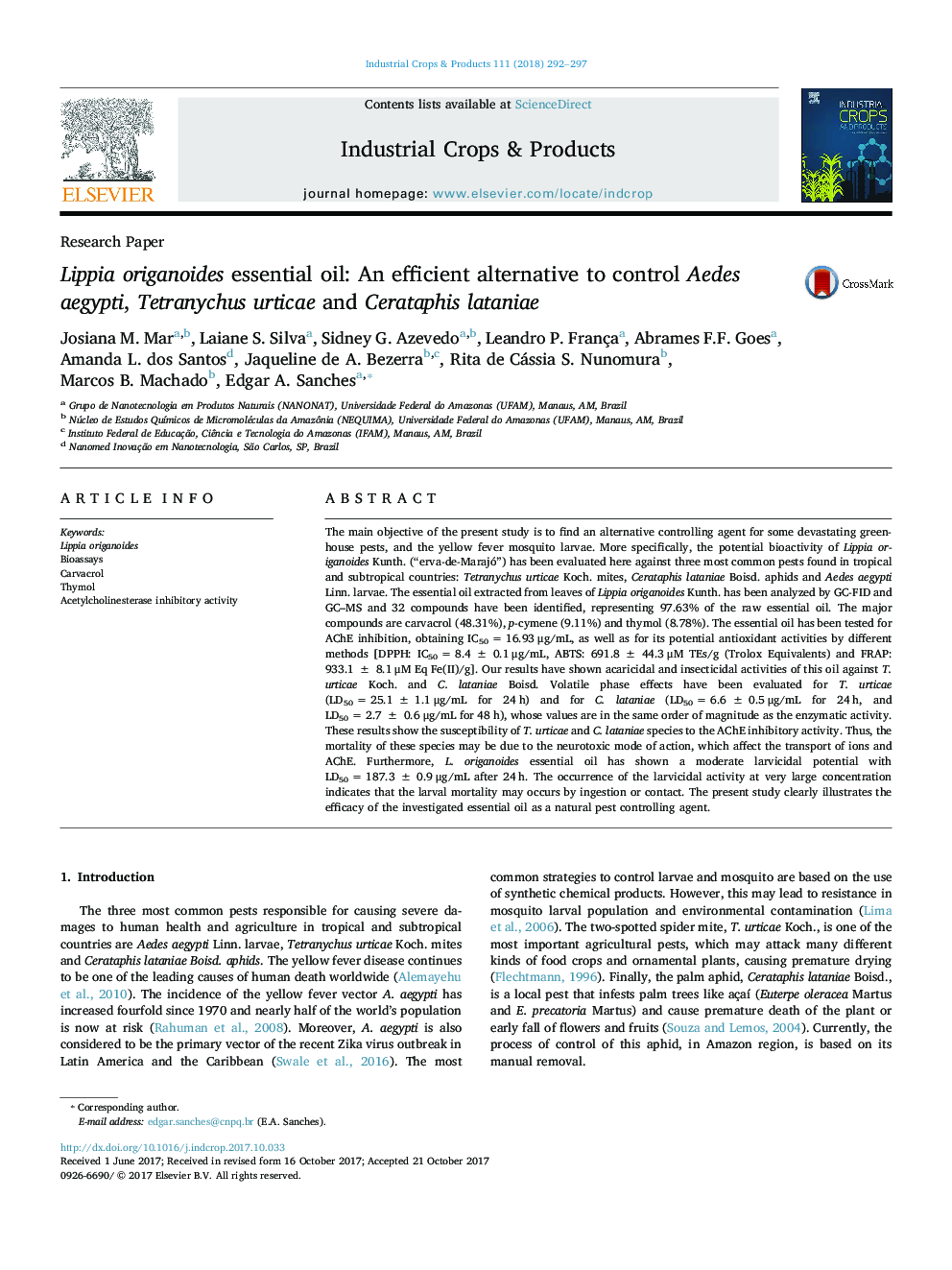| کد مقاله | کد نشریه | سال انتشار | مقاله انگلیسی | نسخه تمام متن |
|---|---|---|---|---|
| 8880976 | 1624799 | 2018 | 6 صفحه PDF | دانلود رایگان |
عنوان انگلیسی مقاله ISI
Lippia origanoides essential oil: An efficient alternative to control Aedes aegypti, Tetranychus urticae and Cerataphis lataniae
دانلود مقاله + سفارش ترجمه
دانلود مقاله ISI انگلیسی
رایگان برای ایرانیان
کلمات کلیدی
موضوعات مرتبط
علوم زیستی و بیوفناوری
علوم کشاورزی و بیولوژیک
علوم زراعت و اصلاح نباتات
پیش نمایش صفحه اول مقاله

چکیده انگلیسی
The main objective of the present study is to find an alternative controlling agent for some devastating greenhouse pests, and the yellow fever mosquito larvae. More specifically, the potential bioactivity of Lippia origanoides Kunth. (“erva-de-Marajó”) has been evaluated here against three most common pests found in tropical and subtropical countries: Tetranychus urticae Koch. mites, Cerataphis lataniae Boisd. aphids and Aedes aegypti Linn. larvae. The essential oil extracted from leaves of Lippia origanoides Kunth. has been analyzed by GC-FID and GC-MS and 32 compounds have been identified, representing 97.63% of the raw essential oil. The major compounds are carvacrol (48.31%), p-cymene (9.11%) and thymol (8.78%). The essential oil has been tested for AChE inhibition, obtaining IC50 = 16.93 μg/mL, as well as for its potential antioxidant activities by different methods [DPPH: IC50 = 8.4 ± 0.1 μg/mL, ABTS: 691.8 ± 44.3 μM TEs/g (Trolox Equivalents) and FRAP: 933.1 ± 8.1 μM Eq Fe(II)/g]. Our results have shown acaricidal and insecticidal activities of this oil against T. urticae Koch. and C. lataniae Boisd. Volatile phase effects have been evaluated for T. urticae (LD50 = 25.1 ± 1.1 μg/mL for 24 h) and for C. lataniae (LD50 = 6.6 ± 0.5 μg/mL for 24 h, and LD50 = 2.7 ± 0.6 μg/mL for 48 h), whose values are in the same order of magnitude as the enzymatic activity. These results show the susceptibility of T. urticae and C. lataniae species to the AChE inhibitory activity. Thus, the mortality of these species may be due to the neurotoxic mode of action, which affect the transport of ions and AChE. Furthermore, L. origanoides essential oil has shown a moderate larvicidal potential with LD50 = 187.3 ± 0.9 μg/mL after 24 h. The occurrence of the larvicidal activity at very large concentration indicates that the larval mortality may occurs by ingestion or contact. The present study clearly illustrates the efficacy of the investigated essential oil as a natural pest controlling agent.
ناشر
Database: Elsevier - ScienceDirect (ساینس دایرکت)
Journal: Industrial Crops and Products - Volume 111, January 2018, Pages 292-297
Journal: Industrial Crops and Products - Volume 111, January 2018, Pages 292-297
نویسندگان
Josiana M. Mar, Laiane S. Silva, Sidney G. Azevedo, Leandro P. França, Abrames F.F. Goes, Amanda L. dos Santos, Jaqueline de A. Bezerra, Rita de Cássia S. Nunomura, Marcos B. Machado, Edgar A. Sanches,